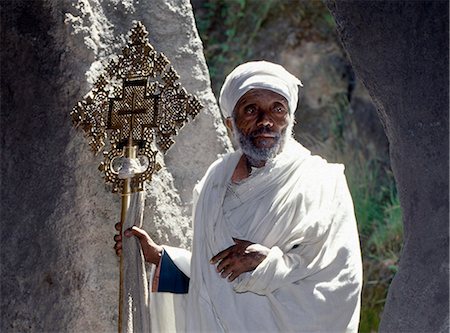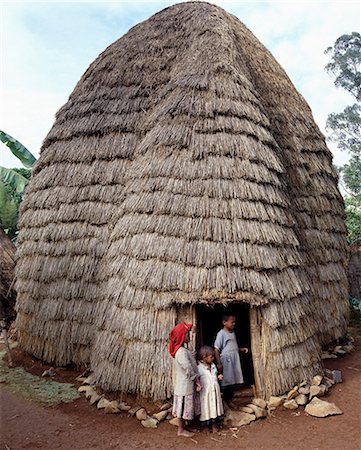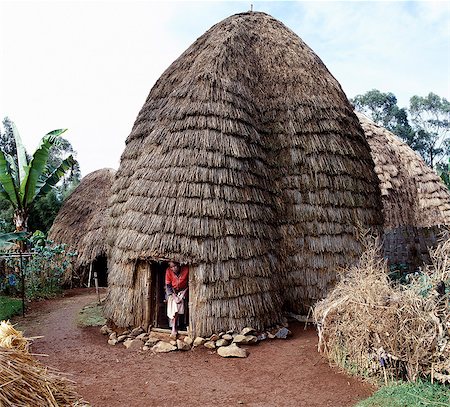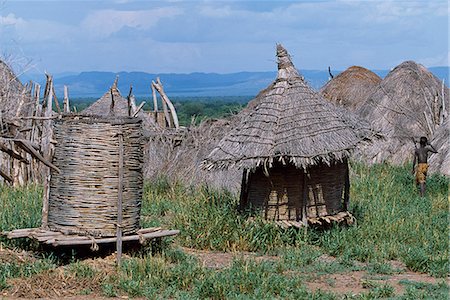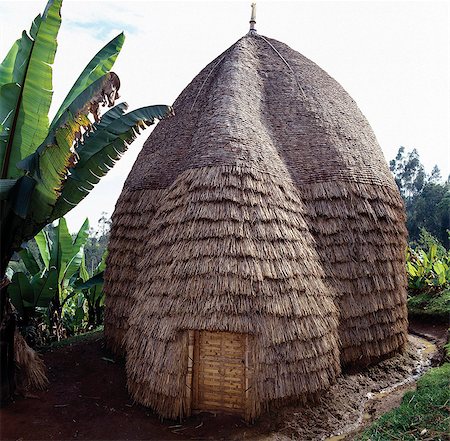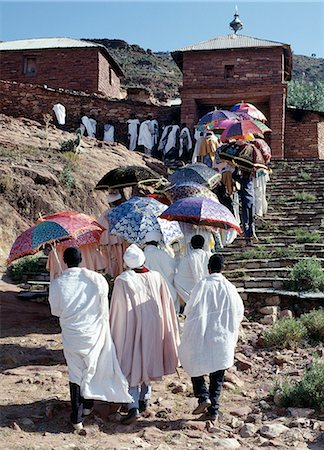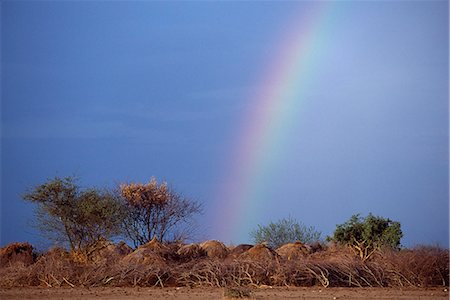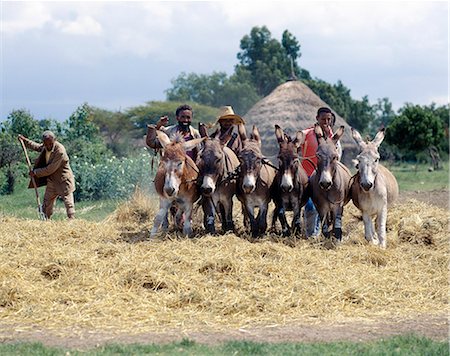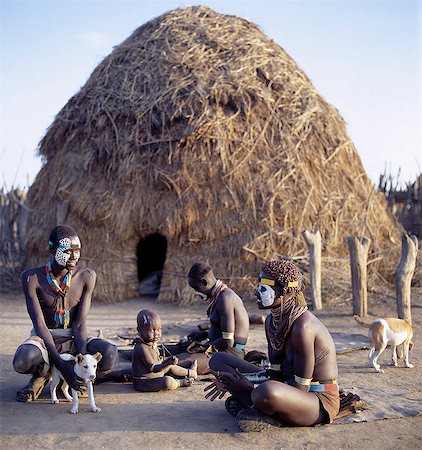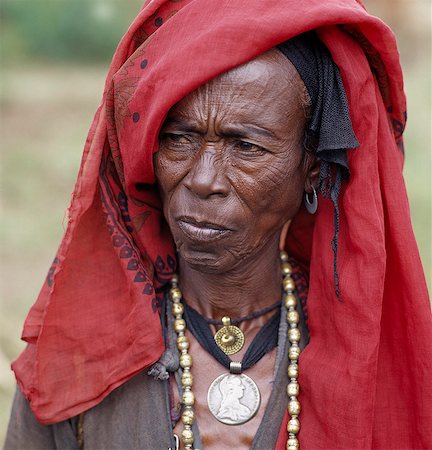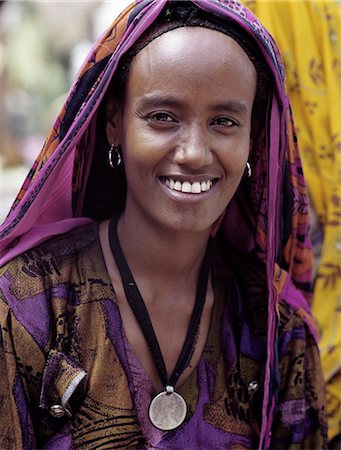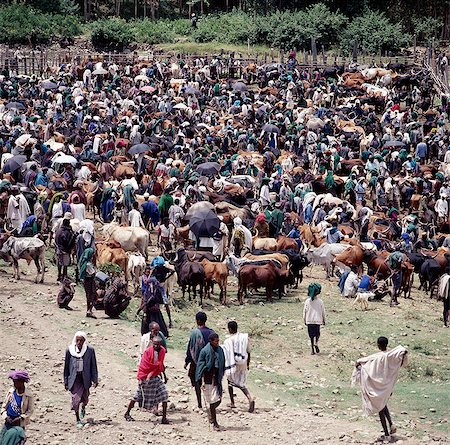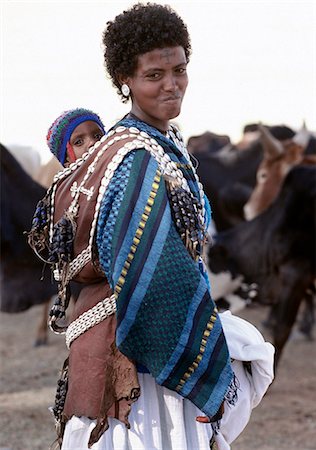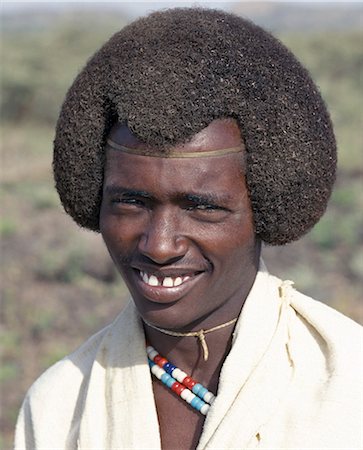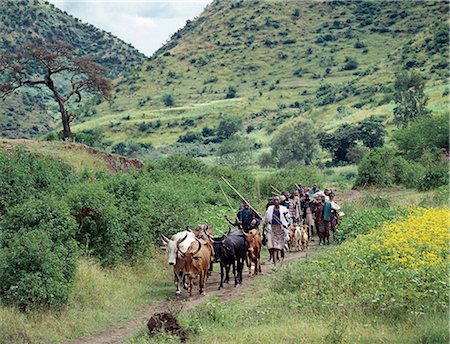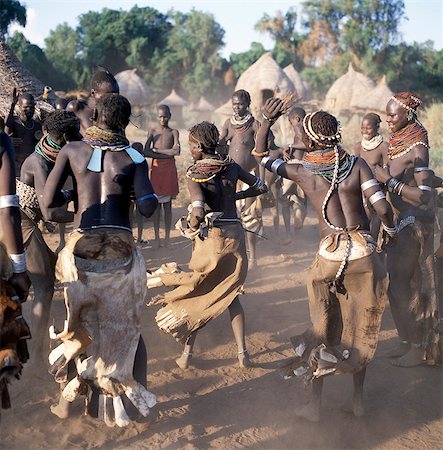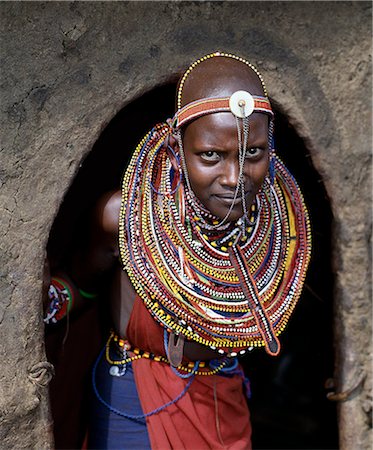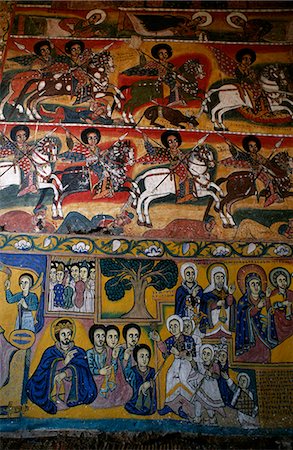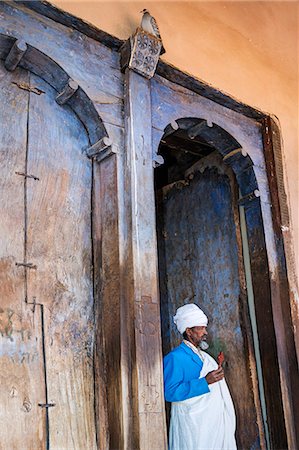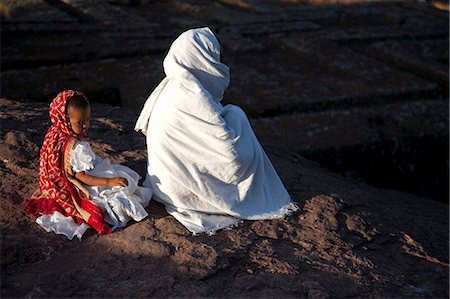-
An attractively decorated traditional thatched house belonging to an Orthodox Christian community in the Ethiopian Highlands,northeast of Addis Ababa. Most Amhara people living in the Ethiopian Highlands adhere to the Ethiopian Orthodox faith. Ethiopia is Africa's oldest Christian nation.
Rights-Managed
-
An attractively decorated traditional thatched house belonging to an Orthodox Christian community in the Ethiopian Highlands,northeast of Addis Ababa. Most Amhara people living in the Ethiopian Highlands adhere to the Ethiopian Orthodox faith. Ethiopia is Africa's oldest Christian nation.
Rights-Managed
-
A homestead of the Arsi-Oromo people west of Aje. The old pot placed over the centre pole of the house is a common roof decoration,and keeps out rain. Small bunches of Teff,a small-grained cereal,are being dried on the thatch.Teff is grown extensively in Ethiopia and is used to make injera,a fermented,bread-type pancake,which is the country's national dish.
Rights-Managed
-
A Nyangatom woman stands with her baby on her hip beside her grass hut in his temporary camp. Nyangatom married women wear elaborately beaded skirts which reach the ground at the back and often have panels of different coloured calkfskin sewn into the tail The Nyangatom or Bume are a Nilotic tribe of semi nomadic pastoralists who live along the banks of the Omo River in south western Ethiopia.
Rights-Managed
-
An old Ethiopian Orthodox priest holds a large brass Coptic cross at the rock hewn church of Adadi Maryam, just south of Addis Abeba. This is the southernmost of Ethiopias rock hewn churches.
Rights-Managed
-
The Dorze people living in highlands west of the Abyssinian Rift Valley have a unique style of building their homes. The twenty foot high bamboo frame is covered with the sheaths of bamboo stems or straw, and resembles a giant beehive.Doorways are set in a bulge of the house, which forms a reception area for guests.These remarkable houses can last for forty years or more.
Rights-Managed
-
The Dorze people living in highlands west of the Abyssinian Rift Valley have a unique style of building their homes. The twenty foot high bamboo frame is covered with the sheaths of bamboo stems or straw, and resembles a giant beehive.Doorways are set in a bulge of the house, which forms a reception area for guests.These remarkable houses can last for forty years or more.
Rights-Managed
-
A fine view from the western scarp of the Abyssinian Rift, just south of Debre Sina where the accumulated layers of basaltic lavas and tuffs lie 3,000 feet thick. The western scarp in this region rises to over 11,000 feet above sea level
Rights-Managed
-
Rich farming country close to the western scarp of the Abyssinian Rift, just north of Debre Sina. Ethiopia is a land of vast horizons and dramatic scenery. Every inch of fertile land is cultivated by hand to feed Ethiopia's population of over 60 million.Agriculture forms the background of the countrys economy with 90 percent of its population earning a living from the land.
Rights-Managed
-
Rich farming country on a highland plateau north of Debre Sina. Ethiopia is a land of vast horizons and dramatic scenery. Every inch of fertile land is cultivated by hand to feed Ethiopias population of over 60 million.Agriculture forms the background of the countrys economy with 90 percent of its population earning a living from the land.
Rights-Managed
-
A small village in the Ethiopian Highlands, northeast of Addis Ababa.The highland plateau rises to over 11,000 feet and is Africas most extensive upland region.The Amhara people who till the land there are Ethiopias largest ethnic group.Every inch of fertile land is cultivated to feed Ethiopias population of over 60 million.
Rights-Managed
-
The grass huts and granary stores of a Nyangatom settlement. The Nyangatom or Bume are a Nilotic tribe of semi-nomadic pastoralists who live along the banks of the Omo River in south-western Ethiopia.
Rights-Managed
-
A young Nyangatom woman carries her baby on her hip in an elaborately braided papoose. Her hair has been reddened with a mixture of ochre and animal fat. Typical of her tribe, she wears a calfskin skirt, multiple layers of bead necklaces and metal bracelets and amulets. The Nyangatom or Bume are a Nilotic tribe of semi nomadic pastoralists who live along the banks of the Omo River in south western
Rights-Managed
-
The Dorze people living in highlands west of the Abyssinian Rift Valley have a unique style of building their homes. The twenty foot high bamboo frame is covered with the sheaths of bamboo stems or straw, and resembles a giant beehive.Doorways are set in a bulge of the house, which forms a reception area for guests.These remarkable houses can last for forty years or more.
Rights-Managed
-
Ethiopian Orthodox priests lead a procession of faithful into Abraha Atsheba Church to celebrate Timkat, the churchs most important Holy Day. Ethiopia is Africas oldest Christian nation where more than half the population follows the Ethiopian Orthodox faith. Priests wear colourful vestments while silk brocade umbrellas shade them from the sun.
Rights-Managed
-
A rainbow rises behind the temporary grass huts of a Nyangatom settlement. The Nyangatom or Bume are a Nilotic tribe of semi-nomadic pastoralists who live along the banks of the Omo River in south-western Ethiopia.
Rights-Managed
-
Donkeys trample corn to remove the grain in a typical rural setting between Ziway and Butajira. Depending on the availability of animals,a farmer may use ponies,donkeys or oxen for this purpose.
Rights-Managed
-
An Afar settlement and livestock close to the Awash National Park. The mountain in the distance is Fantale,a dormant volcano with a large crater from which steam still issues from vents. The most recent lava flow dates back to 1820.
Rights-Managed
-
A Nyangatom woman wears multiple layers of beads in necklaces, an elaborately beaded calfskin skirt and metal bracelets, amulets and anklets. She is standing beside a temporary beehive construction of sticks, grass and leaves built to provide shade for her goats. The Nyangatom or Bume are a Nilotic tribe of semi-nomadic pastoralists who live along the banks of the Omo River in south western Ethio
Rights-Managed
-
In the late afternoon, family and friends sit outside a high dome roofed Karo home.The Karo excel in body art. Before a dance, they will decorate their faces and torsos elaborately using local white chalk, pulverised rock and other natural pigments. The polka dot or guinea fowl plumage effect is popular.
Rights-Managed
-
A Nyangatom girl churns butter in a gourd suspended in the entrance to her hut. Typical of her tribe,she is wearing multiple layers of beads in necklaces,and an elaborately beaded calfskin skirt. The Nyangatom or Bume are a Nilotic tribe of semi-nomadic pastoralists who live along the banks of the Omo River in south-western Ethiopia.
Rights-Managed
-
Scenery between Desse and Bati in the Welo Province of northern Ethiopia with an unfinished thatched house in the foreground. Upturned clay pots are often placed over the protruding centre poles of houses to prevent rain getting in. .
Rights-Managed
-
A Nyangatom girl weaves a grass basket. The Nyangatom or Bume are a Nilotic tribe of semi-nomadic pastoralists who live along the banks of the Omo River in south-western Ethiopia.
Rights-Managed
-
A Karo women stands in the doorway to her hut in the village of Duss. A small Omotic tribe related to the Hamar, who live along the banks of the Omo River in southwestern Ethiopia, the Karo are renowned for their elaborate body painting using white chalk, crushed rock and other natural pigments. In addition to painting her face she has decorated her body with whorls of goat hair tied by leather co
Rights-Managed
-
A Nyangatom woman grinds sorghum using two stones. Typical of her tribe,she wears a heavily beaded calfskin skirt,multiple layers of bead necklaces and metal bracelets and amulets. The Nyangatom or Bume are a Nilotic tribe of semi-nomadic pastoralists who live along the banks of the Omo River in south-western Ethiopia.
Rights-Managed
-
Karo men paint each other in preparation for a dance in the village of Duss. A small Omotic tribe related to the Hamar,who live along the banks of the Omo River in southwestern Ethiopia,the Karo are renowned for their elaborate body painting using white chalk,crushed rock and other natural pigments.
Rights-Managed
-
An old Oromo woman wears a brass necklace and pendant, and a silver pendant made from a Maria Theresa thaler, an old silver coin minted in Austria, which was widely used as currency in northern Ethiopia and Arabia until the end of World War II. With a bright red headscarf, She was on her way to Senbete, an important weekly market close to the western scarp of the Abyssinian Rift.
Rights-Managed
-
A woman at Senbete market wears old silver and brass jewellery.Her two pendants are made from Maria Theresa thalers, old silver coins minted in Austria, which were widely used as currency in northern Ethiopia and Arabia until the end of World War II.Other silver coins have been strung on her necklace.
Rights-Managed
-
An Oromo old woman wears a necklace and a pendant made from a Maria Theresa thaler, an old silver coin minted in Austria, which was widely used as currency in northern Ethiopia and Arabia until the end of World War II. She was on her way to Senbete, an important weekly market close to the western scarp of the Abyssinian Rift.Afar nomads from the low lying arid regions of Eastern Ethiopia trek long
Rights-Managed
-
A woman in a colourful dress and matching headscarf wears round her neck a Maria Theresa thaler an old silver coin minted in Austria, which was widely used as currency in northern Ethiopia and Arabia until the end of World War II.
Rights-Managed
-
A large gathering of people at Senbetes livestock market, which is an important weekly market close to the western scarp of the Abyssinian Rift.Afar nomads from the low-lying arid regions of Eastern Ethiopia trek long distances there to barter with Amhara and Oromo farmers living in the fertile highlands.Agriculture forms the background of the country's economy with 90 percent of its population ea
Rights-Managed
-
A Tigray woman carries her child in a beautifully decorated leather carrier on her back.She has a cross of the Ethiopian Orthodox Church tattooed on her forehead.The people living in the highlands of Northern Ethiopia are deeply religious.
Rights-Managed
-
Ethiopia, Amhara Region, Lasta, Lalibela. At sunrise worshippers attend an early morning outside service at the famous ancient rock-hewn Church of Saint George.
Rights-Managed
-
Ethiopia, Amhara Region, Lasta, Lalibela. At sunrise, worshippers attend an early morning outside service at the famous ancient rock-hewn Church of Saint George.
Rights-Managed
-
A Dassanech woman winnows grain by pouring it from her metal tin and letting it fall onto a calfskin. Much the largest of the tribes in the Omo Valley numbering around 50,000,the Dassanech (also known as the Galeb,Changila or Merille) and Nilotic pastoralists and agriculturalists.
Rights-Managed
-
A young Karo girl in the doorway of her hut in the village of Duss. A small Omotic tribe related to the Hamar,who live along the banks of the Omo River in southwestern Ethiopia,the Karo are renowned for their elaborate body painting using white chalk,crushed rock and other natural pigments.
Rights-Managed
-
A young mother and child of the Arsi-Oromo people west of Aje. Both have unusual hairstyles. The braids falling from the crown of the mother's head have been attractively woven with wool to make a colourful fringe.
Rights-Managed
-
A young Amhara lady weaves a traditional food basket from dried grasses. These large colourful baskets are used for serving injera,a fermented,bread-type pancake,which is the country's national dish.She is wearing the national dress of Ethiopia - a shamma. This garment is made of homespun cotton with a finely woven and often brightly coloured border.
Rights-Managed
-
A young Ethiopian girl with unusual braided hair; the crown of her head has been smeared with a greenish substance. Her two pendants are made from Maria Theresa thalers old silver coins minted in Austria,which were widely used as currency in northern Ethiopia and Arabia until the end of World War II.
Rights-Managed
-
A priest stands outside the rock-hewn church of Abune Yemata in the Gheralta Mountains near Guh.Carved into a cliff face with a sheer drop of 800 to 1,000 feet,the church is reached only by a hazardous ascent with tiny footholds and irregular hand grips. It is renowned for its truly remarkable murals.
Rights-Managed
-
A Kereyu man with his fuzzy,well-oiled hair fashioned in a semi-circular shape. He wears unbleached cloth made from local cotton.
Rights-Managed
-
A Hamar woman implores a man to whip her at a Jumping of the Bull ceremony.Female friends and relatives of the initiate are willing whipped with pliable sticks to show their solidarity and love for him. They do not flinch or show any sign of pain.The semi nomadic Hamar of Southwest Ethiopia embrace an age grade system that includes several rites of passage for young men.
Rights-Managed
-
A Hamar woman being whipped by a man at a Jumping of the Bull ceremony.The semi nomadic Hamar of Southwest Ethiopia embrace an age grade system that includes several rites of passage for young men.
Rights-Managed
-
A Hamar woman holds a tin trumpet at a Jumping of the Bull ceremony.The Hamar are semi nomadic pastoralists of Southwest Ethiopia whose women wear striking traditional dress and style their red ochred hair mop fashion.The Jumping of the Bull ceremony is a rite of passage for young men.
Rights-Managed
-
The framework of a Karo house under construction close to the Omo River. The small thatched huts built off the ground are food stores.The Karo are a small tribe living in three main villages along the lower reaches of the Omo River in southwest Ethiopia.
Rights-Managed
-
The central meeting place, mora, of an old Konso village set in dramatic scenery in southwest Ethiopia. The oldest villages date back 500 to 600 years and are fortified with huge dry stone walls.The Konso people are very industrious farmers, cultivating poor soil on terraces, which are buttressed with stones and rock.
Rights-Managed
-
Farmers drive livestock to Senbete market, which is an important weekly market close to the western scarp of the Abyssinian Rift.Agriculture forms the background of the countrys economy with 90 percent of its population earning a living from the land.
Rights-Managed
-
Ethiopia is a land of vast horizons and dramatic scenery. The weathered mountains in the Ethiopian Highlands exhibit layer upon layer of volcanic material, which built the plateau into Africas most extensive upland region.Agriculture forms the background of the country's economy with 90 percent of its population earning a living from the land.
Rights-Managed
-
A group of Maasai warriors,resplendent with long Ochred braids,chat outside their traditional houses. These squat houses with rounded corners have roofs plastered with a mixture of soil and cow dung,so need regular repairs during rain.
Rights-Managed
-
A Dassanech woman milks a cow by hand collecting the milk in a gourd at a settlement alongside the Omo River. Much the largest of the tribes in the Omo Valley numbering around 50,000,the Dassanech (also known as the Galeb,Changila or Merille) are Nilotic pastoralists and agriculturalists.
Rights-Managed
-
A Datoga woman relaxes outside her thatched house.The traditional attire of Datoga women includes beautifully tanned and decorated leather dresses and coiled brass armulets and necklaces.The Datoga live in northern Tanzania and are primarily pastoralists.
Rights-Managed
-
An Ethiopian man wears a headdress made from the skin of a gelada, a unique baboon like primate that lives at high altitudes in northern Ethiopia, and a cloak embroidered with Ethiopias imperial lion.
Rights-Managed
-
A Mursi child is carried safely in her mothers decorated leather garments.The Mursi speak a Nilotic language and have affinities with the Shilluk and Anuak of eastern Sudan.They live in a remote area of southwest Ethiopia along the Omo River.
Rights-Managed
-
A lively Nyangatom dance is enjoyed by villagers in the late afternoon.The elevated houses in the background are both homes and granaries, which have been built to withstand flooding when the Omo River bursts its banks The Nyangatom are one of the largest tribes and arguably the most warlike people living along the Omo River in Southwest Ethiopia.
Rights-Managed
-
A Nyangatom mother and young daughter in typical dress. Rugged skin clothing is still widely used.The Nyangatom are one of the largest tribes and arguably the most warlike people living along the Omo River in Southwest Ethiopia.
Rights-Managed
-
With oiled and blackened bodies, a group of young men who have already completed their initiation ceremony participate in a Hamar Bull Jumping ceremony of a friend by circling the cattle before the climax to the ceremony takes place.After the ceremony, the initiate attains full manhood and is permitted to marry
Rights-Managed
-
Hamar men line up steers at a Jumping of the Bull ceremony.The semi nomadic Hamar of Southwest Ethiopia embrace an age grade system that includes several rites of passage for young men.After the ceremony, the initiate attains full manhood and is permitted to marry
Rights-Managed
-
With whipping sticks in their hands, men crouch as they bless an initiate who is about to perform his Jumping of the Bull ceremony.The Hamar are semi nomadic pastoralists of Southwest Ethiopia who embrace an age grade system that includes several rites of passage for young men.
Rights-Managed
-
A thatched house of the Tsemay people of remote Southwest Ethiopia.The girls and women wear attractively decorated leather skirts and aprons, and braid their hair in a number of different eye catching styles.Broad leather shoulder bands decorated with cowrie shells are a common adornment.
Rights-Managed
-
Fertile farming land surrounds Lake Ashange in northern Ethiopia.Ethiopia is a land of vast horizons and dramatic scenery. The weathered mountains in the Ethiopian Highlands exhibit layer upon layer of volcanic material, which built the plateau into Africas most extensive upland region.
Rights-Managed
-
Ethiopian Orthodox priests perform the Dance of the Priests to celebrate Timkat, the churchs most important Holy Day. Ethiopia is Africas oldest Christian nation where more than half the population follows the Ethiopian Orthodox faith. During Timkat, priests stand in two rows, facing one another and sway gently as they chant. Attendants hold silk brocade umbrellas to shade them from the sun
Rights-Managed
-
Two Giriama girls pound corn outside their home using a large wooden mortar and pestles. Their small skirts are made from strips of printed cotton material - a traditional dress of Giriama women and children.
Rights-Managed
-
A Giriama girl from Kenya's Coast Province carrying a gourd full of water on her head. Her small skirt is made from strips of printed cotton material.
Rights-Managed
-
A young Galla herdsboy with his family's cattle outside their homestead.
Rights-Managed
-
A young Maasai girl in all her finery pauses at the entrance to her mother's home. The wall and roof of the house are plastered with a mixture of cow dung and soil.
Rights-Managed
-
Maasai girls in all their finery and with bells tied round their legs wait at the entrance to a house before dancing with warriors.
Rights-Managed
-
A young Turkana girl wearing an attractively beaded leather apron and belt stands outside her mother's home. Sansevieria or wild sisal lines the lower walls of the house. Cicatrization round the nipples of a girl is not an uncommon form of beautification.
Rights-Managed
-
A Turkana woman makes the final ties to the dome-shaped framework of her home. In wet weather,hides will be laid on top and secured with leather thongs.
Rights-Managed
-
As the sun rises above the forested peaks of Mount Nyiru,members of a Turkana family chat and plan their day's activities outside their domed-shaped homes,which provide scant protection from the elements.
Rights-Managed
-
Two young Dassanech boys sport elaborate clay hairdos at their settlement alongside the Omo River. Much the largest of the tribes in the Omo Valley numbering around 50,000,the Dassanech (also known as the Galeb,Changila or Merille) are Nilotic pastoralists and agriculturalists.
Rights-Managed
-
A young Dassanech girl holds her little brother. She wears a leather skirt with an elaborate fringe of wooden and metal tassles. Much the largest of the tribes in the Omo Valley numbering around 50,000,the Dassanech (also known as the Galeb,Changila or Merille) are Nilotic pastoralists and agriculturalists.
Rights-Managed
-
A young Dassanech girl holds her little brother. She wears a leather skirt with an elaborate fringe of wooden and metal tassles. Much the largest of the tribes in the Omo Valley numbering around 50,000,the Dassanech (also known as the Galeb,Changila or Merille) are Nilotic pastoralists and agriculturalists.
Rights-Managed
-
A tourist accompanied by a retinue of children in a Dassanech settlement along the lower Omo River. Much the largest of the tribes in the Omo Valley numbering around 50,000,the Dassanech (also known as the Galeb,Changila or Merille) and Nilotic pastoralists and agriculturalists.
Rights-Managed
-
A tourist accompanied by a retinue of children in a Dassanech settlement along the lower Omo River. Much the largest of the tribes in the Omo Valley numbering around 50,000,the Dassanech (also known as the Galeb,Changila or Merille) and Nilotic pastoralists and agriculturalists.
Rights-Managed
-
Ethiopian Christmas day celebrations (Genna),Bet Maryam Church,Lalibela,Ethiopia. Holy men carry Axunite hand crosses. Cloths are used when holding these,to keep them clean. Colourful umbrellas are also an important part fo the religious symbolism employed in Ethiopia.
Rights-Managed
-
Ura Kidane Meret Church boasts some of the finest 16th century murals,most painted in the maqdas,or inner sanctuary,of any Ethiopian church.
Rights-Managed
-
A Tigray homestead overlooks the spectacular Gheralta Mountains in Northern Ethiopia. Flat-roofed stone houses,which are common throughout Tigray Province,may have been introduced into Ethiopia from Arabia as early as 700 BC.
Rights-Managed
-
Portrait of a man holding Christian symbols,Gabriel and Raphael,Bieta Mercurios,Lalibela,Wollo region,Ethiopia,Africa
Rights-Managed
-
Ethiopia, Abraha Atsbeha, Tigray Region. A Coptic priest outside the huge wooden doors of the semi monolithic 10th century church of Abraha Atsbeha.
Rights-Managed
-
A Dassanech girl braids her sister's hair at her village in the Omo Delta. Much the largest of the tribes in the Omo Valley numbering around 50,000,the Dassanech (also known as the Galeb,Changila or Merille) and Nilotic pastoralists and agriculturalists.
Rights-Managed
-
Ethiopia, Lalibela. A woman prays by Bet Giyorgis, whilst her daughter loses concentration.
Rights-Managed
-
Ethiopia, Lalibela. Crowds gather to worship on Sunday around Bet Giyorgis.
Rights-Managed
-
Ethiopia, Lalibela. A priest in one of the ancient rock-hewn churches of Lalibela.
Rights-Managed
-
Ethiopia, Lalibela. A priest in one of the ancient rock-hewn churches of Lalibela.
Rights-Managed
-
Ethiopia, Lalibela. A priest in one of the ancient rock-hewn churches of Lalibela.
Rights-Managed
-
An Afar girl has tribal scarification on her cheeks. Scarification is practiced in only a few sections of her tribe. Proud and fiercely independent,the nomadic Afar people live in the low-lying deserts of Eastern Ethiopia.
Rights-Managed
-
A Hamar woman at Turmi Market.The Hamar are semi-nomadic pastoralists of Southwest Ethiopia whose women wear striking traditional dress Skins are widely used for clothing and heavy metal necklaces,bracelets and anklets form part of their adornments. Cowries are also popular to embellish a woman's appearance.
Rights-Managed
-
A smart young Hamar youth at Turmi Market.The Hamar are semi-nomadic pastoralists who live in harsh country around the Hamar Mountains of Southwest Ethiopia. Their whole way of life is based on the needs of their livestock. Cattle are economically and culturally their most important asset.
Rights-Managed




